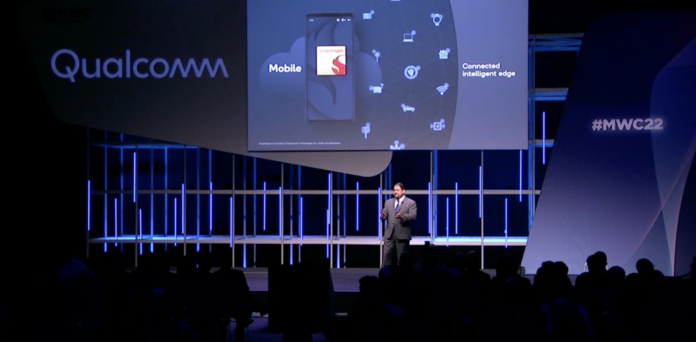As it continues to focus on addressable market growth as a function of moving core mobile expertise into high-value adjacencies, Qualcomm dropped a massive amount of news—16 press releases, in fact—as CEO Cristiano Amon took the stage at Mobile World Congress in Barcelona. The big picture here, as Amon put it, “Mobile technology is literally going everywhere. As we see this evolution of mobile technology going everywhere, we see this incredible opportunity for the company in what we call the connected intelligent edge.”
The premise here is that the number of connected devices, in the consumer segment but largely as enterprises invest in digital transformation, is set for a huge ramp. Those new devices, things like video cameras, environmental sensors, robots, vehicles, etc…will always be connected to central and/or edge cloud computing infrastructure. “This is not only an opportunity for connectivity but for smart processing, artificial intelligence, and everything that is going to happen at the edge. We'[ve] positioned ourselves as the company that’s going to drive innovation at the edge and power the connected intelligent edge,” Amon said.
By the numbers, Amon said the cloud market is growing 35% year-over-year and that sustaining that growth is predicated on the availability of billions of connected, smart devices. “If you believe in the growth of the cloud, then you believe in the growth of Qualcomm and the mobile industry and the edge.” The goal is to expand total addressable market from $100 billion to $700 billion in the next decade.
Beyond continued leadership in modem to antenna solutions and other smartphone hardware and software, target growth segments for Qualcomm include compute, automotive, Industry 4.0 and 5G network modernization which draws in work on mmWave and 5G RAN platforms with an emphasis on virtualized, open networking.
In terms of core technology with broad applicability, including in smartphones, Qualcomm unveiled:
- The Snapdragon X70 5G Modem-to-RF system has built-in AI to optimize 5G speed, coverage, latency and power efficiency with broad support for all global 5G bands.
- A commercial-first Wi-Fi 7 product with features like 4K QAM and high-band simultaneous multi-link in the FastConnect 7800 subsystem.
- New Snapdragon Sound features like lossless CD-quality audio, stereo recording via earbuds, latency reduction, improved Adaptive Active Noise Cancellation and end-to-end optimization for LE Audio sharing and broadcasting.
On the networking side, Qualcomm announced:
- The Private Networks RAN Automation Platform to help hasten private network deployments and reduce cost and complexity. This comes with a partner ecosystem program that has put together pre-integrated packages aligned to vertical-specific use cases.
- In a collaboration with Microsoft, Qualcomm is combining its 5G technology and hardware ecosystem with Microsoft Azure’s private MEC and core solutions for pre-integrated, turnkey private enterprise 5G networks.
- vRAN software specialist Mavenir is working with Qualcomm on massive MIMO radio and distributed units for Open RAN networks.
- With Fujitsu, Qualcomm is working on integrating 5G mmWave technologies into RUs and DUs as part of NTT DOCOMO’s 5G Open RAN Ecosystem (OREC).
- As fixed wireless access draws operator interest, Qualcomm enhanced its FWA platform to include support RF sensing and Standalone 5G mmWave, and self-installed CPEs.
- With Italian operator FastWeb is using the latest FWA platform to offer up mmWave-based FWA services.
In automotive, Qualcomm’s Snapdragon Digital Chassis has won broad business across global vehicle manufacturers and the company has a multi-billion dollar revenue pipeline. At the MWC Barcelona the firm announced:
- An as-a-service model for Snapdragon Car-to-Cloud Services with integrated analytics and both on-device and cloud-supported applications.
- The Snapdragon Telematics Framework which gives vehicle OEMS the ability to access telematics capabilities across all platforms covered by Snapdragon Digital Chassis.
- A combined Wi-Fi 6E and Bluetooth 5.3 chipset for enhanced vehicular connectivity.
Qualcomm is pushing to grow the base of 5G-equipped PCs as well as foster an ecosystem around Snapdragon Windows on Arm. Relevant MWC announcements include:
- Snapdragon X65 and X62 5G M.2 modules, developed with Foxconn and Quectel to help OEMs more quickly add 5G capabilities to laptops and desktops.
- Lenovo’s new ThinkPad X13s is using the latest Snapdragon 8cx Gen 3 compute platform that brings in 5G, AI and enterprise-grade security to a Windows 11 PC using the Snapdragon compute platform. More broadly, Qualcomm is working with device OEMs, ISVs, operators and channel partners to grow the Arm-based Snapdragon compute ecosystem with an eye on enterprise use cases.
In the industrial space, Qualcomm partnered up with a focus on industrial automation and smart utility operations:
- With Bosch Rexroth, Qualcomm showed industrial IoT solutions that are running in a Bosch factory in Germany and use 5G features like URLLC, TSN, CoMP and advanced positioning for autonomous mobile robots and assisted guided vehicles.
- With Gridspertise, a subsidiary of energy giant the Enel Group, Qualcomm is developing smart grid solutions and service with an eye grid reliability, flexibility, resiliency and maintenance simplification.
“We’re very excited about the speed of innovation and how our partnerships continue to grow,” Amon said at the end of the press conference.
Click here to watch Amon’s MWC Barcelona press conference.
Editor’s note: As we continue to unpack Qualcomm’s news drops, look forward to more coverage in these digital pages, as well as on our sister site Enterprise IoT Insights, throughout the week.

